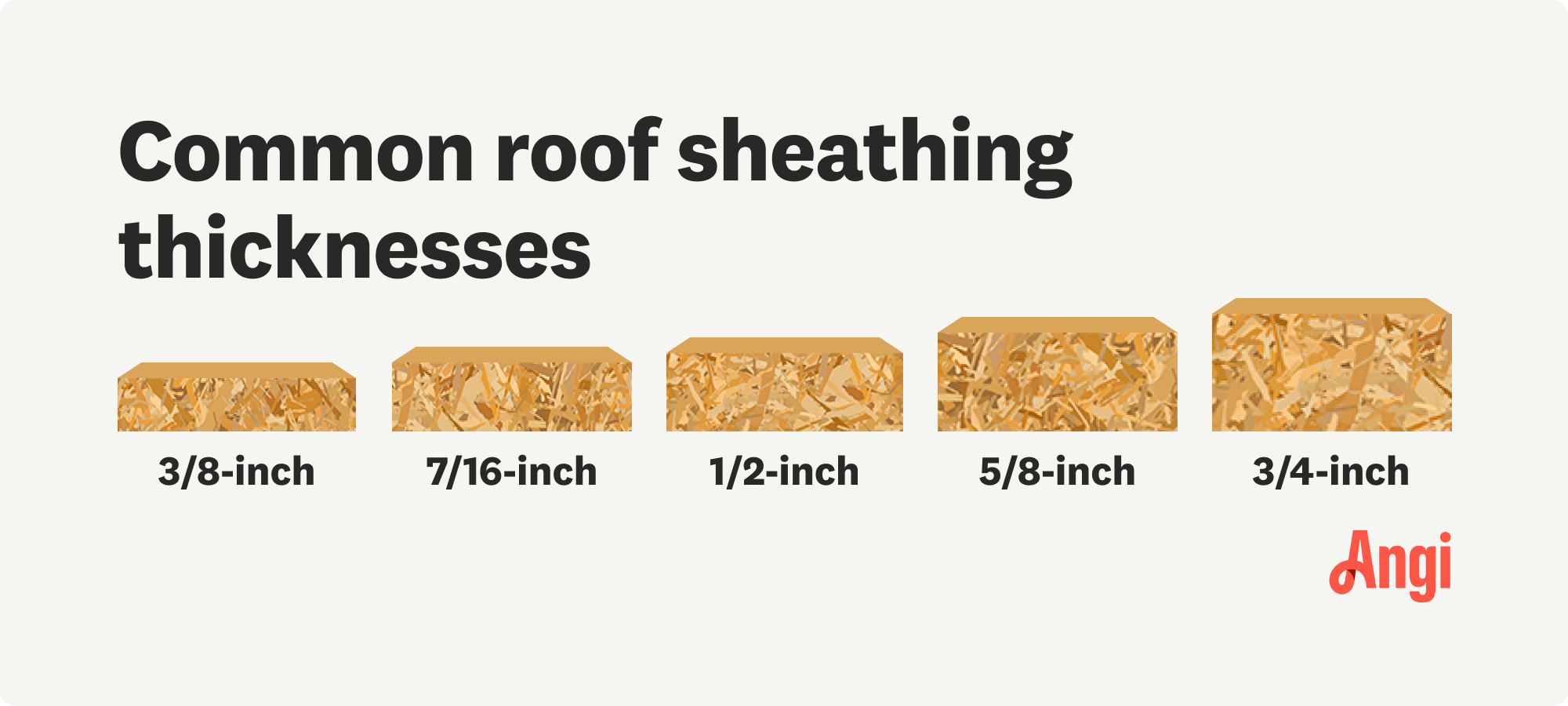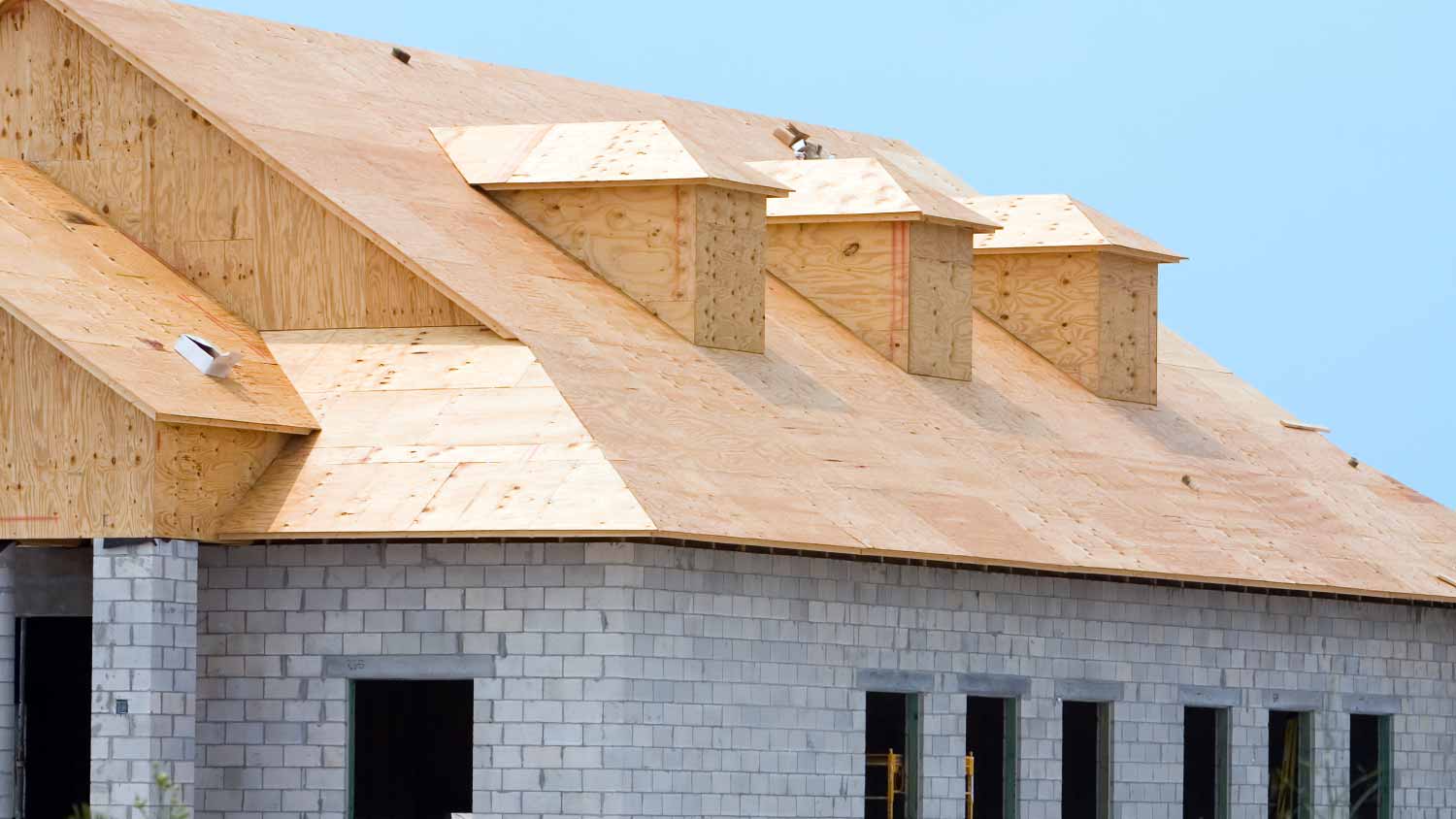Roof Sheathing Thickness: What Size Do I Need?
Sheath any concerns about the thickness of your roof sheathing


Roof sheathing supports the weight of roofing materials and prevents sagging and other damage.
Plywood and oriented strand board (OSB) are two of the most common sheathing materials.
Sheathing ranges in thickness from 3/8 to 3/4 of an inch.
The most common sheathing thicknesses are 7/16, 1/2, and 5/8 of an inch.
Replacing your roof requires the right material for structure and support. Roof sheathing, also known as roof decking, is the foundation your roofing material is affixed to, acting as a support between the rafters and the roof itself.
It’s important to choose the right roof sheathing thickness to support the roof's weight and prevent sagging, bending, or—in the worst-case scenario—collapse. Learn more about roof sheathing and how to determine the right thickness to support your roof and protect your home.
What Is the Standard Thickness for Roof Sheathing?
Roof sheathing comes in 8-by-4-foot sheets and is available in thicknesses ranging from 3/8 to 3/4 of an inch. The most commonly used roof sheathing thicknesses are 7/16, 1/2, and 5/8 of an inch. Choosing the right thickness for roof sheathing is critical for the structural stability of your roof—it needs to be thick enough to support the weight of the roofing material plus any additional expected weight like snow or ice.
Roof sheathing also provides an additional layer of protection from water damage, protecting your rafters and roof insulation. The thicker the roof sheathing, the more stable your roof will be, especially when working with heavy roofing materials or in areas that receive a lot of snow and ice.

Roof Sheathing Thickness by Material

Different roof sheathing materials vary in thickness depending on their strength and weight-supporting capacity. Plywood and oriented strand board (OSB) are the most commonly used sheathing materials.
| Material | Rafter Spacing (in.) | Minimum Thickness (in.) |
|---|---|---|
| Plywood | 16–32 | 1/2–5/8 |
| Oriented Strand Board (OSB) | 16–24 | 7/16–5/8 |
Plywood
Plywood is one of the most popular sheathing materials. It’s often favored in wetter climates due to its ability to dry quickly and retain its original shape after swelling from moisture. Plywood commonly comes in sheets ranging from 1/2 to 3/4 of an inch thick. Plywood sheathing costs an average of $1.40 to $5 a square foot, although lumber prices can fluctuate considerably. Because plywood isn’t quite as strong as oriented strand board, its minimum thickness is slightly thicker.
Oriented Strand Board
Oriented strand board (OSB) is made from compressed wood fibers mixed with resin. It is structurally stronger than plywood and comes in sheets in thicknesses from 7/16 to 5/8 of an inch. OSB sheathing averages between $0.65 and $2.40 per square foot, making it a more cost-effective option than plywood. One caveat with OSB, however, is that it warps when wet, so it may not be the best choice for areas that receive a lot of rain.
How to Calculate Roof Sheathing Thickness
Determining the right thickness for roof sheathing is a matter of safety and structural stability, so it may be best to leave this job to the pros. If you’re working with a local roofing company, your roofer will be able to determine the appropriate thickness for your roof sheathing.
The necessary sheathing thickness will depend on local building codes and the specifics of your roof’s construction and materials. Check with your local building authority to see if there are any required minimum measurements before getting started on your roof. In most cases, 7/16 of an inch when working with OSB or 1/2 an inch for plywood will be the minimum thickness you should choose for lighter roofing materials.
To find out how much sheathing you’ll need once you determine the proper thickness, calculate your roof’s square footage and divide that by the square footage per sheet of sheathing, allowing an additional 10% to 15% allowance for waste and errors.
Factors That Influence Roof Sheathing Thickness

There’s no one-size-fits-all answer for the right thickness for roof sheathing. Every roof will have different needs, and various factors will affect which thickness is appropriate for your roof.
Roofing Material Weight
The most important function of roof sheathing is to support the roofing material, so the material you use will be a deciding factor in how thick your sheathing should be. Heavier roofing materials like slate, clay, and wood shingles require thicker sheathing and lighter materials like asphalt shingles can often use thinner sheathing.
The roofing material you choose will affect almost every aspect of your roof replacement cost, so be sure to factor any additional costs, like sheathing, into your budget.
Expected Snow and Ice Weight
In addition to the weight of the roofing materials, you need to consider the expected added weight of snow or ice on the roof in colder climates. Snow and ice can put tremendous pressure on a roof, so it’s critical that the sheathing material is thick enough to support not only the roof itself but also the added weight that winter weather can bring.
Rafter Spacing
The distance between rafters can also affect how thick your roof sheathing needs to be. Roof rafters are typically spaced between 16 and 32 inches apart. The wider the distance, the more stress is placed on the center of the sheathing, so rafters that are farther apart require thicker sheathing.
What to Do if You Have the Wrong Thickness Roof Sheathing
Having the wrong thickness roof sheathing is one of the most serious roofing mistakes you can make. If your sheathing isn’t thick enough to support the roof's weight, you could end up with a roof that’s sagging, bowing, or even collapsing under its own weight. Roof damage can also lead to water intrusion, mold growth, and damage to your home from the top down.
A failing roof is a serious safety issue, so it’s important to address it as soon as you suspect there’s a problem. Problems with your sheathing will quickly become evident, so if you see any buckling or sagging roof sections, water damage, or leaks, it’s time to call in the pros. Choose a roofer who can identify the problem with your sheathing and determine the correct replacement material and thickness to prevent future problems.





- Roofers
- Metal Roofing
- Roof Repair
- Roof Inspection
- Vinyl Siding Repair Contractors
- Flat Roofing Companies
- Commercial Roofing
- Emergency Roofing Companies
- Leaky Roof Repair
- Metal Roof Repair
- Business Roof Repair
- Flat Roof Repair
- Tile Roof Repair
- Slate Roofers
- Rubber Roofers
- Roofing & Siding
- Metal Roof Installation
- Affordable Roofing
- Roof Sealing
- Attic Ventilation Contractors
- What Is Roof Sheathing and How Does It Work?
- Roofing Terms and Definitions Every Homeowner Needs to Know
- Hot Roof vs. Cold Roof: What’s the Difference?
- How to Build a Roof For Your Home, From Start to Finish
- How to Fix a Leaking Roof [2024 Guide]
- 12 Parts of Roof Framing You Should Know
- 7 Signs of a Bad Roofing Job and What to Do Next
- 9 Warning Signs You Need a New Roof
- 9 Ways to Help Your Roof Last Longer
- Why Are There Soft Spots on My Roof and Are They a Problem?










